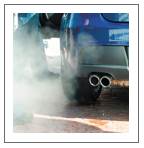
Concept explainers
Automobile exhaust is a major cause of air pollution. One pollutant is the gas nitrogen oxide, which forms from nitrogen and oxygen gases in the air at the high temperatures in an automobile engine. Once emitted into the air, nitrogen oxide reacts with oxygen to produce nitrogen dioxide, a reddish brown gas with a sharp, pungent odor that makes up smog. One component of gasoline is heptane, C7H16, a liquid with a density of 0.684 g/mL. In one year, a typical automobile uses 550 gal of gasoline and produces 41 lb of nitrogen oxide. (7.4, 7.8, 8.6)
a. Write balanced chemical equations for the production of nitrogen oxide and nitrogen dioxide.
b. If all the nitrogen oxide emitted by one automobile is converted to nitrogen dioxide in the atmosphere, how many kilograms of nitrogen dioxide are produced in one year by a single automobile?
c. Write a balanced chemical equation for the combustion of heptane.
d. How many moles of gaseous CO2 are produced from the gasoline used by the typical automobile in one year, assuming the gasoline is all heptane?
e. How many liters of carbon dioxide at STP are produced in one year from the gasoline used by the typical automobile?

Two gases found in automobile exhaust are carbon dioxide and nitrogen oxide.
Trending nowThis is a popular solution!

Chapter 9 Solutions
CHEMISTRY: AN INTRODUCTION TO GENERAL, O
- Please provide steps to work for complete understanding.arrow_forwardPlease provide steps to work for complete understanding.arrow_forwardIdentify the Functional Groups (FG) in the following molecules. Classify C atoms as tertiary, 30, or quaternary 40. Identify secondary 20 and tertiary, 30 hydrogen atoms. Please provide steps to undertand each labeling.arrow_forward
- Identify the Functional Groups (FG) in the following molecules. Classify C atoms as tertiary, 30, or quaternary 40. Identify secondary 20 and tertiary, 30 hydrogen atoms. Please provide steps to undertand each labeling.arrow_forwardIdentify the Functional Groups (FG) in the following molecules. Classify C atoms as tertiary, 30, or quaternary 40. Identify secondary 20 and tertiary, 30 hydrogen atoms. Please provide steps to undertand each labeling.arrow_forwardIdentify the Functional Groups (FG) in the following molecules. Classify C atoms as tertiary, 30, or quaternary 40. Identify secondary 20 and tertiary, 30 hydrogen atoms. Please provide steps to undertand each labeling.arrow_forward
- A certain chemical reaction releases 24.7 kJ/g of heat for each gram of reactant consumed. How can you calculate what mass of reactant will produce 1460. J of heat? Set the math up. But don't do any of it. Just leave your answer as a math expression. Also, be sure your answer includes all the correct unit symbols. mass M 0.0 x μ 00 1 Garrow_forwardPlease don't used hand raiting and don't used Ai solutionarrow_forwardDon't used Ai solutionarrow_forward
- Don't used hand raitingarrow_forwarda) Propose a method to synthesize the following product. More than one step reaction is required. (10 marks)arrow_forwardthe vibrational frequency of I2 is 214.5 cm-1. (i) Using the harmonic oscillator model, evaluate the vibrational partition function and the mean vibrational energy of I2 at 1000K. (ii) What is the characteristic vibrational temperature of I2? (iii) At 1000K, assuming high-temperature approximation, evaluate the vibrational partition function and the mean vibrational energy of I2. (iv) Comparing (i) and (iii), is the high-temperature approximation good for I2 at 1000K?arrow_forward
 Introductory Chemistry: A FoundationChemistryISBN:9781337399425Author:Steven S. Zumdahl, Donald J. DeCostePublisher:Cengage Learning
Introductory Chemistry: A FoundationChemistryISBN:9781337399425Author:Steven S. Zumdahl, Donald J. DeCostePublisher:Cengage Learning ChemistryChemistryISBN:9781305957404Author:Steven S. Zumdahl, Susan A. Zumdahl, Donald J. DeCostePublisher:Cengage Learning
ChemistryChemistryISBN:9781305957404Author:Steven S. Zumdahl, Susan A. Zumdahl, Donald J. DeCostePublisher:Cengage Learning
 Chemistry: An Atoms First ApproachChemistryISBN:9781305079243Author:Steven S. Zumdahl, Susan A. ZumdahlPublisher:Cengage Learning
Chemistry: An Atoms First ApproachChemistryISBN:9781305079243Author:Steven S. Zumdahl, Susan A. ZumdahlPublisher:Cengage Learning Chemistry: The Molecular ScienceChemistryISBN:9781285199047Author:John W. Moore, Conrad L. StanitskiPublisher:Cengage Learning
Chemistry: The Molecular ScienceChemistryISBN:9781285199047Author:John W. Moore, Conrad L. StanitskiPublisher:Cengage Learning General Chemistry - Standalone book (MindTap Cour...ChemistryISBN:9781305580343Author:Steven D. Gammon, Ebbing, Darrell Ebbing, Steven D., Darrell; Gammon, Darrell Ebbing; Steven D. Gammon, Darrell D.; Gammon, Ebbing; Steven D. Gammon; DarrellPublisher:Cengage Learning
General Chemistry - Standalone book (MindTap Cour...ChemistryISBN:9781305580343Author:Steven D. Gammon, Ebbing, Darrell Ebbing, Steven D., Darrell; Gammon, Darrell Ebbing; Steven D. Gammon, Darrell D.; Gammon, Ebbing; Steven D. Gammon; DarrellPublisher:Cengage Learning





